Artist Interview -Daisuke Matsumoto- Part 1
写真というよりはコンセプトアートを⾒ているような気分。ユーモラスな雰囲気の中に、何か”思うところがある…”と、作家からの問題提起を感じずいられない写真。
アーティストインタビューの第三弾は、現代写真家のマツモトダイスケさんです。今回もご本⼈の背景から 7 ⽉ 27 ⽇より始まる展⽰会の話など、⾊々とお話を伺いました。
It’s like looking at a piece of concept art rather than a photograph. It’s humorous, but you can’t help but feel that the artist is trying to raise some kind of issue.
The third in our series of artist interviews is contemporary photographer Daisuke Matsumoto. This time, we talked with him about his background, the exhibition that starts on July 27th, and many more things.
・開催期間 :2021年7月27日(火)- 8月2日(月)
・営業時間 :12:00-20:00
・場所 :「no-ma」at 渋谷PARCO
・住所 :東京都渋谷区宇田川町13-17 ライズビル1階
・企画:TOKYO URBAN ART
Period: July 27, 2021 (Tuesday) – August 2, 2021 (Monday)
Opening hours: 12:00 – 20:00
Location: “no-ma” at Shibuya PARCO
Address: Rise Building 1F, 13-17 Udagawa-cho, Shibuya-ku, Tokyo
Planning: TOKYO URBAN ART
今回(前編)はご本⼈のアーティストとしてのバックボーンについてお聞きしています。
それでは、どうぞ!
This time (Part 1), we would like to ask about the backbone of his career as an artist.
Here we go!
‒早速ですが、写真を撮り始めた経緯を教えてください。
家にカメラがあり、⼦供の頃から写真⾃体がとても⾝近でした。⾃分でもおもちゃのトイカメラや写ルンですを持ち歩いたり、天才バカボンのトイカメラを修学旅⾏に持って⾏ったりしていました。その時は、将来写真家になろうと考えていたわけではないのですが…。
意識をし始めたのは、レコードのジャケット写真を通してかな。元々バンドをやっていたので、レコードのジャケットが好きで、特に初期のパンクとかハードコアとか、それが最初のキッカケだと思います。
地元が⿃取の⽥舎なので情報が少なくて、⾳楽雑誌を読んでも実際にはその CD が⼿に⼊らなかったりしました。だけど雑誌を通してこの⼈かっこいいな、とかって思っていましたね。
⾳楽に関する写真が好きで、その流れで*野村浩司さんを知って、彼の写真集を買ったり、インタビューを読んだりしていくなかで、*ヒプノシスとか⾊々なキーワードを知って、知識が広がっていきました。
※野村浩司…カメラマン。ミュージシャンの CD ジャケットや雑誌の表紙などを主に⼿がける。2014 年逝去。
※ヒプノシス…アルバムアートワーク界の巨匠集団。ピンクフロイド、レッド・ツェッペリンなどが有名。
⽇本⼈でも松任⾕由実、佐野元春などを⼿がけている。
-Please tell us how you started taking pictures.
I had a camera at home, and photography itself was very close to me since I was a child. I used to carry around a toy camera and a “Utsurun Desu” (Film with Lens, FUJIFILM), and I also took a toy camera of “Genius Bakabon” with me on school trips. At that time, I was not thinking of becoming a photographer in the future, but…
I guess I first became aware of it through record jacket photography. I used to be in a band, so I liked record jackets, especially early punk and hardcore, and I think that was my first inspiration.
My hometown is in rural areas in Tottori, so there was not much information available, and even if I read a music magazine, I could not actually get the CD. However, I always thought that this person was cool through magazines. I liked pictures of music, and through that, I came to know about *Koji Nomura, and through buying his photo books and reading interviews, I learned about *Hipgnosis and various keywords, and my knowledge expanded.
*Koji Nomura: Japanese photographer. He mainly works on CD jackets for musicians and magazine covers. He passed away in 2014.
*Hipgnosis: An English art design group that specialized in creating cover art for the albums of musicians and bands. Notable commissions included work for Pink Floyd, Led Zeppelin, among Japanese musicians, Yumi Matsutoya and Motoharu Sano.

‒作品づくりにおいての「⾃分」を形成していったモノがあれば教えてください。
漫画と映画かな。写真集より漫画を多く持っています。(笑)
好きな漫画を聞かれたときには、古⾕実の「稲中卓球部」って答えています。(笑)
古⾕実は「シガテラ」のシリアス路線も好きですが、ギャグの⽅が好きです。特に「僕といっしょ」までのギャグベースだけど少しシリアスな感じ。
あとは望⽉峯太郎も好きで、少⼥漫画とかジャンプも⼤好きです。今⽇もジャンプは買って帰ります。(笑)
※古⾕実…漫画家。多くの作品がドラマ化、映画化している。ギャグ漫画から不条理漫画へシフトしていった路線はファンに衝撃を呼んだ。
※望⽉峯太郎…漫画家。「ドラゴンヘッド」「鮫肌男と桃尻⼥」などで知られる。
-Please tell us about the things that formed your “self” in creating your work.
Comics and movies, I guess. I have more manga than photo books lol
When people ask me what my favorite manga is, I tell them ” The Ping-Pong Club ” by *Minoru Furuya lol
I like the serious side of Furuya Minoru’s work, like “Ciguatera”, but I like the gag side of his work. Especially up to “Boku to Issho”, which is gag-based but a bit serious.
I also like *Mochizuki Minetaro, and I like girls manga and *Weekly Shōnen Jump a lot. I’ll buy it again today and go home lol
*Weekly Shōnen Jump: The popular Japanese comic magazine and published weekly.
*Furuya Minoru and Mochizuki Minetaro are Japanese manga writers.
– 少⼥漫画までとは、ジャンルが幅広いですね!
でもアメコミとかは苦⼿で、派⼿なものよりも刹那的なものが好きなのかもしれません。
⽔⽊しげるさんが地元なので図書館とかで普通に読んでいて、なんとなく妖怪⽂化とかの暗さが⾃分の中に根付いていたかもしれないですね。東京に出てから気づいたのですが、そもそも僕は⼭陰と呼ばれる地域で育ったのですが、⽂字通り、どこか暗いんですよね。
逆に⼭陽と⾔われる広島の⼈たちは明るいし。そういうのも関係しているのかもしれません。
– You’ve got a wide range of genres, even from those girls comics!
But I’m not really a fan of American comics, and I guess I prefer ephemeral things rather than flashy ones. Shigeru Mizuki’s hometown is the same as mine, so I used to read his books at the library and so on, and somehow the darkness of yokai culture might have been rooted in my mind. After I moved to Tokyo, I realized that I grew up in a region called *”San’in” region, and as the Chinese character says, I have a dark character. On the contrary, like people in Hiroshima prefecture, which is known as the *”San’yo” region, are cheerful. That may be related to it.
*San’in is written as “山陰”. The word “陰” means shadow. Sanyo, on the other hand, is written as “山陽”. The word “陽” means sun.
– 映画はどんなものを?
⺟が特撮好きで、ウルトラマン、ゴジラ、仮⾯ライダーなどをよく⾒ていましたね。
初めて連れて⾏かれたのは「ウルトラ Q」で、怖くて⼤泣きしました。それで翌週はドラえもんの映画に連れて⾏ってもらった記憶があります。
※ウルトラ Q…ウルトラマンで知られる円⾕プロダクションによる怪奇ドラマ。海外のホラードラマに影響を受け作られたドラマなのであまり⼦供向けではない気がする…
– What kind of movies did you watch?
My mother was a big fan of special effects shows, so I often watched Ultraman, Godzilla, and Masked Rider.
The first time she took me to the theater was to see *“Ultra Q”. I was so scared that I cried a lot. The next week, I remember being taken to a Doraemon movie.
*UltraQ: This is a SF drama produced by Tsuburaya Productions, known for Ultraman.
It was inspired by foreign horror dramas, so it’s not really suitable for children…
‒⿃取県といえば植⽥正治さんが⽣まれた街というイメージがありますよね。その辺はバックグラウンドに影響していたりはするのですか?
※植⽥正治…⿃取で亡くなるまで活動したカメラマン。⾃らをアマチュアと⾃称しながらも、独⾃の前衛的な演出写真は世界でも知られるほどの写真家だった。
植⽥正治さんは、写真を⾊々と勉強していく過程で凄い⼈だと知ったのですが、実は同じ町内会のご近所でした。⾃分の祖⽗と植⽥正治さんは、よく喫茶店でお喋りするような間柄で、たまに祖⽗の家に預けられた時には僕もお会いしていたのですが、当時は何も分かっていなかったので普通のカメラ屋のおじいちゃんという印象でした。
ちなみに初めてカメラを買ったのは植⽥さんのカメラ屋で、当時はカメラの選び⽅もわかっていないから、すぐに決めて「これ買う!!」って、(そうしたら店番をしていた植⽥さんの 娘さんに)「カッコいい〜」って⾔われました。(笑)
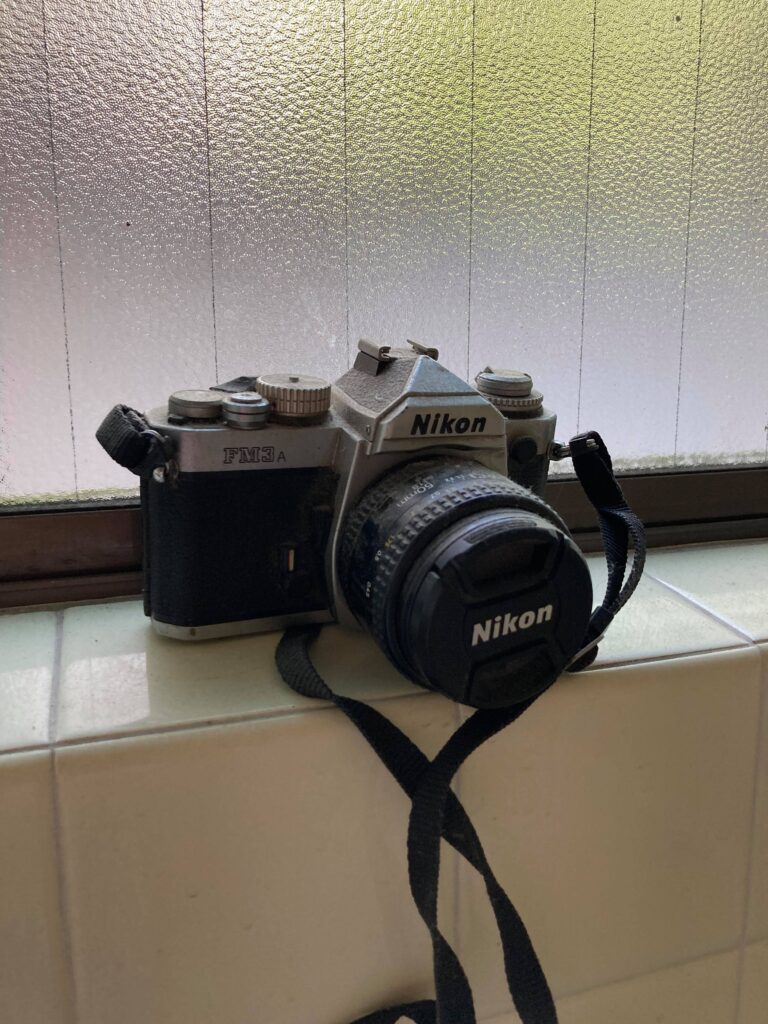
-When it comes to Tottori Prefecture, there is an image that this is the place where *Shoji Ueta was born. Does that have any influence on your background?
*Shoji Ueda: He was a photographer who worked in Tottori, Japan until his death. Although he called himself an amateur, his avant-garde directional photography was known throughout the world.
He was actually a neighbor of mine from the same neighborhood association, which I found out through studying photography. My grandfather and he used to chat at cafe and I used to meet him when my grandpa would leave me at his house, but I didn’t know anything about him at the time, so I just thought he was an ordinary old man in a camera shop.
By the way, the first time I bought a camera was at Mr. Ueda’s camera shop, and since I didn’t know how to choose a camera at that time, I decided right away to buy this one. (Then his daughter who was working at the store) said to me, “That’s so cool!“ lol
‒ここまでのお話だと、ある意味、写真家になるべくしてなったような強いエピソードばかりですが、その後、専⾨的な勉強などはしたのですか?
芸術系の⾼校を⽬指していたのですが、落第しちゃって…。結局は商業⾼校に⼊ったのですがつまらなくて中退しました。狭い街なので、新しく出来た友達とは学校に⾏かなくても遊べるし、何より興味をもてないことに時間を割くことが勿体ないと思って…。その後、写真部だった友達から⾼校の卒業資格がなくても⾏ける⼤阪の専⾨学校を教えてもらって、進学しました。
-The story so far is full of episodes where it seems like you were meant to be a photographer, but did you do any specialized study after that?
I was aiming for an art school, but I failed…. In the end, I entered a commercial school, but it was boring, so I dropped out. It was a small town, so I could hang out with my new friends without having to go to school, and I thought it was a waste of time to spend on something I wasn’t interested in. After that, a friend of mine who was in the photography club told me about a vocational school in Osaka that allowed me to carry out my studies without needing to have a valid altitude school diploma, and I decided to go there.
‒専⾨学校時代は印象的な思い出とかはありますか?
その専⾨学校は美⼤などとは違い、アカデミックな要素がなくて、⽣徒も写真館の⼆代⽬とかが多い学校でした。当時はフィルムでモノクロを撮っていたのですが、その様なこともあってか、学校には現像する為だけに⾏く、作品は作るけど課題は提出しない、という様な学⽣⽣活でした。
-Do you have any impressive memories from your time at your vocational school?
The school was different from an art college in that it was not an academic school and many of the students were second generation photography studio owners. At that time, I was shooting black and white film, and perhaps because of this, my student life was such that I would only go to school to develop film, and I would make work but not submit any assignments.
‒フィルムでモノクロというのは現在の作⾵と違いますね。いつ頃からスタイルを確⽴していったのですか?
最初はドキュメンタリーなスナップを撮っていました。カメラを持ち歩いて、いつも撮っている感じですね。卒業制作くらいから、コンセプトや画を決めてから撮るというスタイルになっていきました。19、20 歳の頃。
モノクロでプリントしていると森⼭⼤道さんみたいになりがちで、周りもそういう作⾵が多かったので「⼈のやっていないことをやろう!!」と思ったのが最初です(笑)
※森⼭⼤道…カメラマン。より明確に撮る事が課題であるはずの撮影に「アレ・ブレ・ボケ」を持ち込み、写真表現のあり⽅に衝撃を与えた。
This is different from the way I work now. When did you start to develop your style?
At first, I was taking documentary snaps. I carried my camera around with me and was always taking pictures. When I was 19 or 20 years old, I started to take pictures after deciding on a concept or picture for my graduation project.
When I was printing in black and white, my work tended to be like that of Daido Moriyama and many people around me were also doing that kind of work. So I thought, “Let’s do something no one else is doing!” lol
*Daido Moriyama: A photographer. He has brought “rough, blurred and out-of-focus.” into photography, which is supposed to be a challenge to take clearer pictures, and has shocked the world of photographic expression.
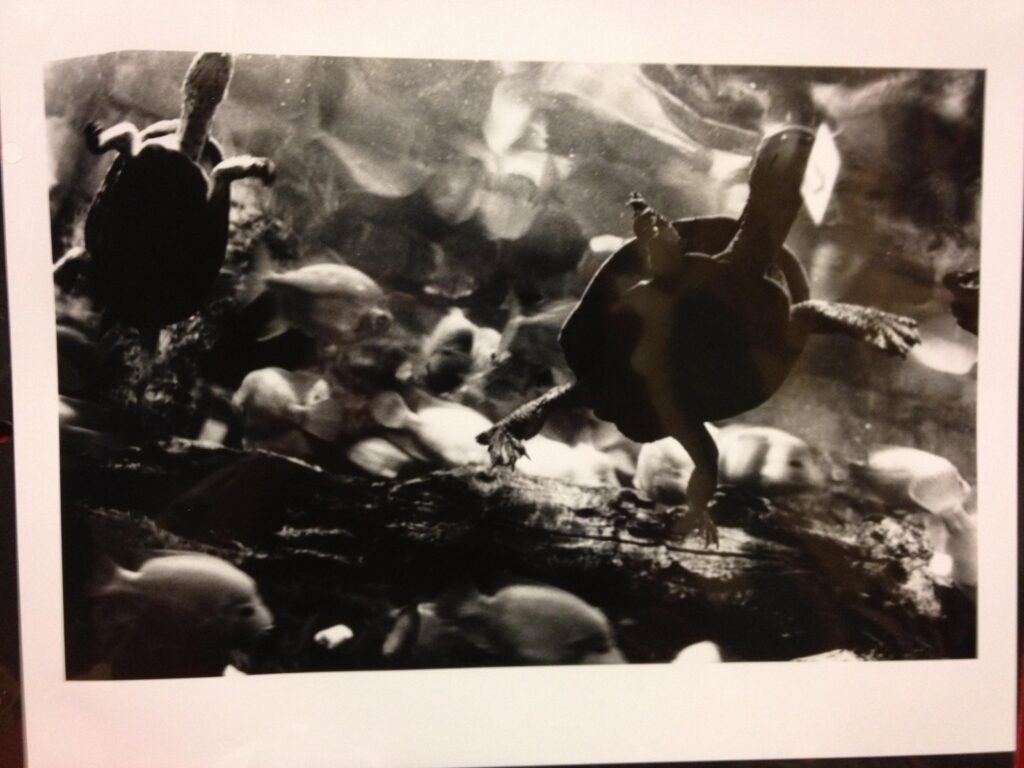
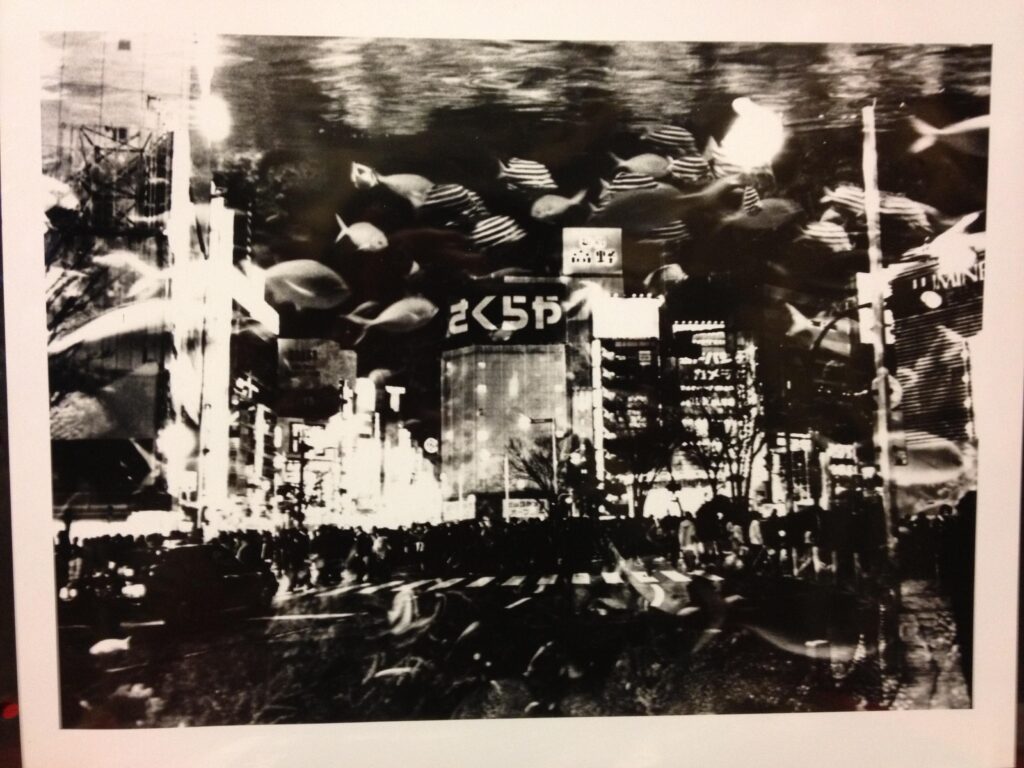
‒今の作⾵はコント的なアプローチも感じる⼀⽅で、どこかエグる様なメッセージ性も感じます。切り替わったタイミングの作品はどのようなものだったのでしょうか?
まずコント的な部分については、『ごっつええ感じ』の影響は⼤きいですね…。
※ダウンタウンのごっつええ感じ…ダウンタウンを代表するバラエティ番組。コント企画が⼈気を博した。
被り物シリーズはウルトラマンとかゴジラの作品が最初で、そこからデジタルでカラーの作⾵に切り替わっていきました。幼馴染の絵描きの友⼈に作品を⾒てもらった時に、かっこつけすぎじゃない?と⾔われて腹が⽴って、そこから好きなことしてやるぞと(笑)
-The current strategy is one that feels like a skit, but also has an emotional message. What was your work like when you made the switch?
First of all, in terms of contrast, the influence of “Downtown no Gottsu Ee Kanji” is huge….
*Downtown no Gottsu Ee Kanji: a Japanese variety show.
The first time I did the mask series was for Ultraman and Godzilla, and from there I switched to digital and color work. When a friend of mine from childhood who is a painter saw my work, and told me it was too cool. That made me angry, so I decided to do whatever I wanted lol
‒そこで思いついたのがウルトラマンとゴジラを戦わせると(笑)
その後東京でグループ展を⾏った際に、メインは別の作⾵だったのですが、⼀画にその⼿の作品を置いておいたら、そっちの⽅がウケてリアクションも良かったので、試しにコンペに出したら賞を獲ってしまって。
そこから、ギャラリーで展⽰できたり写真集を出したりできる流れが⽣まれました。
-That’s when you came up with the idea of having Ultraman and Godzilla fight each other lol
After that, when a group exhibition was held in Tokyo, the main focus was on another type of work, but I placed one part of the work on the corner and the reaction was good, so I submitted it to a competition and won a prize.
From there, I was able to display my work in galleries and publish photo books.
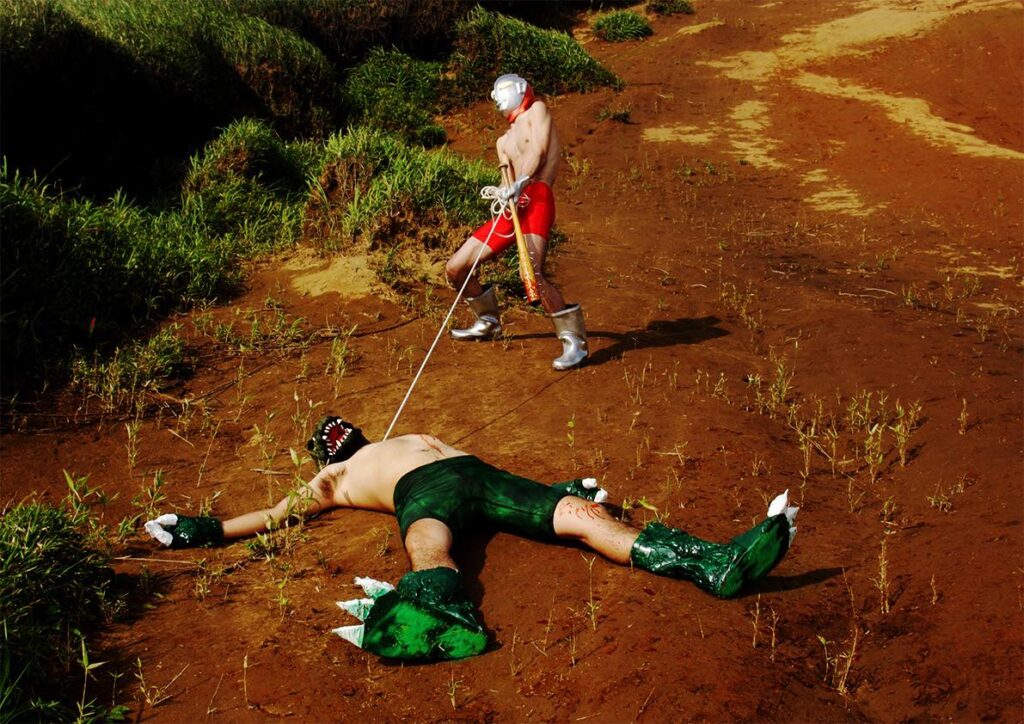
‒ちなみに個⼈的にはマクドナルドのドナルドの写真がすごく意味ありげでインパクトが強かったです。
あれってやっぱり⾵刺的な意図が…?
⾵刺をしているつもりはないのですが…、(しばらく黙り込み) いや、あるといえばあるのですが、なにをやろうかなあと考えた時に、ドナルド・マクドナルドというキャラクターが思い浮かんで、そこから関連的にビーフ 100%って⾔葉が思いついて。その⼀⽅では当時、パティをミミズで作っている!みたいな都市伝説があったじゃないですか?
そこから、あれはミノタウルスなんですけど、ドナルドがミノタウルスを狩っているストーリーって⾯⽩いなって。本当は緑の草原でやりたかったのですが、雪が降っちゃって、それでも決⾏したため、モデルの⼦が凍傷になってしまって⼤変でした…(笑)
-For me personally, the picture of Donald from McDonald’s was very meaningful and had a strong impact. Do you have any special intentions for this?
I don’t mean to be cynical, but… (silent for a while) No, I’d say there is, but when I was thinking about what to do, the character of Ronald McDonald came to mind, and then the phrase “100% beef” came to mind. On the other hand, at that time there was an urban myth that patties were made from worms, wasn’t there?
I thought it would be a great idea to have a story about Donald hunting a minotaur, even though it is a minotaur. I wanted to do it in a green meadow, but it was snowing, but I still decided to do it, and the model got frostbite, so it was very tough…lol
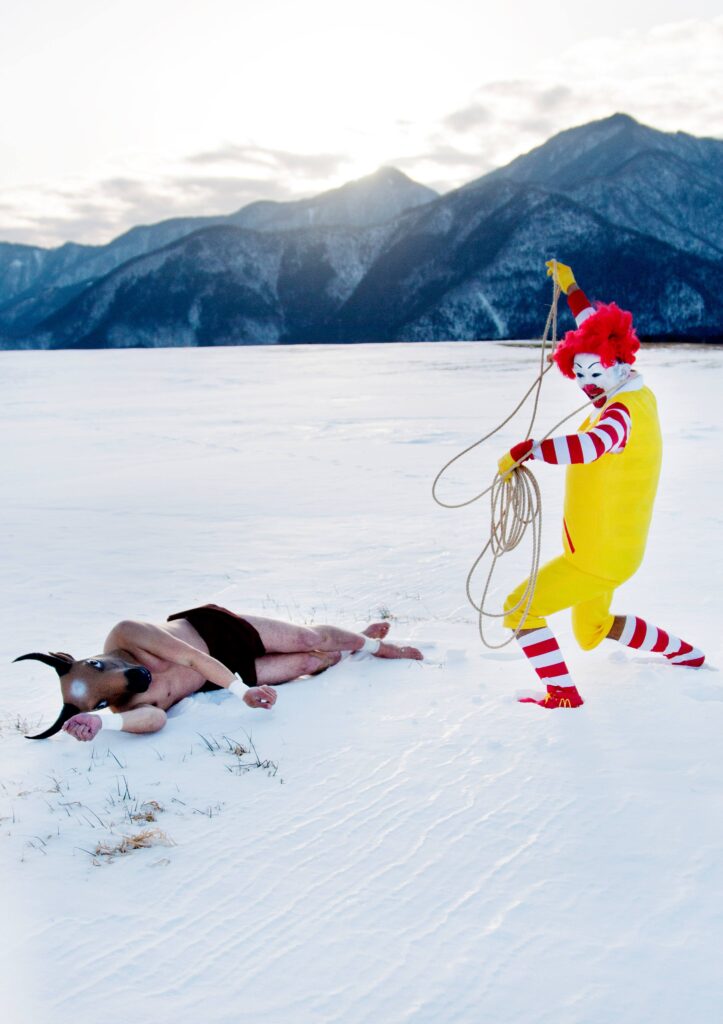
‒ぼくたちはミノタウルスを⾷べているかもしれない…と。そして雪原だったのはそういう事情だったのですね(笑)
初⾒の⼈にはかなりインパクトのある作品だと思いますが、インスピレーションはどこか ら湧いてくるのですか?
そもそもストーリーを考えるのが好きなのかな。あと…、パッと思いついちゃう…。
制作過程としては浮かんできたものを⾁付けするために物事を調べて、根拠を強めていく。社会的にどうにかしようとかではなくて、絵とかアイデアが出て、そこから始まっていく。そこに現代的な状況、美術的な歴史などの⽂脈を掘り下げて⾁付けしていく形です。その過程の⽅が撮影より、ずっと時間がかかりますね。
-We might be eating a minotaur… And that’s why it was in a snowfield lol
This is quite a striking work for first viewers. How did you get your inspiration?
I guess I like to think of stories in the first place. Also…I can come up with them in a flash…
In the process of creating the work, I look into things in order to put the ideas into perspective, and strengthen the evidence. I don’t try to do something socially, but I start with a picture or an idea and go from there. It’s a way of adding more context to the work, such as the contemporary situation and the history of art. That process is much more time consuming than shooting.
続いて、出版という表現⽅法で発信する、型にハマらない作品”SOULS”の話を中⼼にお聞きしました。SOULS を紹介している web サイトなどは⾒ましたが、そこだけでは分からないこの未知な媒体について⾊々聞いていきます!
Next, we focused on the unconventional work “SOULS”, which is transmitted through the expression of publishing. We’ve seen the websites that introduce SOULS, but we couldn’t get a clear picture of this unknown medium from there!
-⾃らで発刊されている SOULS について教えていただいてもらってよろしいでしょうか?
これから 20年後、30年後にもっと⾯⽩くなりそうな⼈たちを取り上げようと。ただ僕は写真家なのでインタビューというのも違うから、彼らに⽂章を書いてもらって、それをインスピレーションに写真を撮るというような形式です。
-Can you tell me about the SOULS that you publish yourself?
I decided to take people who will be even more interesting in the next 20 or 30 years. But since I’m a photographer, it’s not like an interview, so I asked them to write a text and use it as an inspiration to take pictures.


「SOULS」の⼀部を公開。ぜひ気軽に購⼊ができる媒体なので Instagram の情報を追っかけてみてください!
Instagram→@SOULS_tokyo
A part of “SOULS”. It’s a medium that you can easily purchase, so please follow the information on Instagram!
-セブンイレブンのネットプリントという形態は珍しい気がするのですが、この形を取った理由はどうしてなのでしょうか?
最初はフリーペーパーで⾊々な場所に設置しようと思ったのですがコロナで難しくなって、セブンイレブンのネットプリントという形にしました。セブンイレブンなら⽇本全国どこ にでもありますからね。まぁ僕の地元⿃取県のセブンイレブンは⽇本国内で最後にできたんですけど(笑)でも、そんな⿃取でも読むことができますし地元の友達も⾒てくれています。
また、電⾞の待ち時間とか、読んでいる⼈たちの⽣活のスキマに⼊り込みたいという想いから、ポケットに⼊る⽂庫本サイズにしました。
I think the form of *online printing at 7-Eleven is unique, but why did you take this form? What is the reason for this form?
*You can print photos and documents from multi-printer at the Convenience Store like 7-Eleven in Japan.
At first, I tried to put up free papers in various places, but it became difficult at Corona pandemic, so I decided to use Seven-Eleven’s online printing service. You can find Seven-Eleven stores all over Japan. Well, the Seven-Eleven in my hometown in Tottori prefecture was the last one to open in Japan lol But you can still read the magazine in Tottori and my friends in my hometown are also enjoying it.
Also, I wanted to fit it into the pocket size of a paperback book, for example, while waiting for a train or in a gap in the life of the reader.
–web にしなかった理由はあるのですか?
なんとなくの話になるのですが、web で簡単に⾒ることが出来てしまうと意味を成さないと思いました。ネットプリントを使いつつ紙で出てくるというアナログとデジタルの中間に位置するアプローチが⾃分のやりたいことなのではないかと考えています。
ただタイムラインに流れるものを⾒るという⽂脈と本を買って読む⽂脈は違いますよね。買うことで受け⼿側にも「⾒るぞ」という覚悟がある。だからこそフィジカルがあるものにしたくて、webで完結したくないって思いがありました。
-Is there a reason why you didn’t go with the web version?
Somehow, I thought it would not make sense if it could be easily viewed on the web. I think the approach that lies between analog and digital, using online printing and coming out in paper, is what I want to do.
There’s a difference between the context of just watching something on a timeline and the context of buying and reading a book. Buying a book means the recipient is prepared to see it. That’s why I wanted it to be physical and not just be on the web.
-緻密な設計があるのですね。すごく納得をしました。
ちなみに発刊しようと思ったキッカケはどのようなものなのでしょうか?
⾼校の時に好きなミュージシャンが載っているという理由で、伊賀⼤介さんの「First time― 伊賀⼤介・MOTOKO」という、分厚いポートレート写真集を買いました。
数年後、そのまた数年後と時間が経ってから読み返すと、「あれ?こんな⼈載ってたの??」という様に、知識や経験を得て新しい発⾒があるんです。それこそ当時は全く知らなかったのですが実は*会⽥誠さんが載っていたりとか。
そこで、⾃分がいままで遊んできた⼈たちの写真を撮っておく必要があるなと。ただ真似をしたりポートレートだけ撮っても仕⽅ないと思い、結果として現在の様な内容になりました。
*会⽥誠…⽇本の現代美術家、アーティスト。グロ・エロ、その他にも過激なテーマの持つ作品を作り、常にセンセーショナルな話題を発信していく。
-So, there is a meticulous planning. It made a lot of sense to me.
By the way, how did you come up with the idea of publishing this book?
When I was a teenager, I bought a thick book of portraits by Daisuke Iga called “First time – Daisuke Iga・MOTOKO” because it had some of my favorite musicians in it.
When I read it again a few years later, and a few years after that, I found myself thinking, “What? I didn’t know there were any people in the book?” It’s a new revelation when you look at it after you’ve gained knowledge and experience. For example, *Makoto Aida is actually in the magazine, which I didn’t know at the time.
So I realized that I needed to take pictures of the people I have been playing with. I thought that just copying or taking portraits was not the way to go, and as a result, the content became what it is today.
*Makoto Aida: A Japanese contemporary artist. He creates works with extreme themes, such as grotesqueness and eroticism etc. He is always producing sensational topics.
-GEZAN のマヒトゥ・ザ・ピーポーさんや切腹ピストルズや新進のアーティストなどを取り上げる⼀⽅で、⼩学⽣などもフィーチャーすると web サイトで拝⾒した紹介⽂に書いてあったのですが⼩学⽣の記事って実際にあるのですか?
友達の⼦供でリュウってヤツがいて、お願いしているのですが中々書いてくれない(笑)
⼩さい頃から⾃分たちの遊び場のライブハウスやアートギャラリーに出⼊りしていて、みんな可愛がるから、⾊々叩き込むんですよ。DJ やらギターやらコーヒーの淹れ⽅やら。そんなせいか、先⽇、最近どういうことに興味ある?って聞いたら「宇宙」って(笑)
–The introductory text I saw on the website said that the magazine would also feature elementary school students, while also featuring GEZAN’s MahiToThePeople, the Seppuku Pistols, and other up-and-coming artists but is there actually an article on elementary school students?
I have a friend’s kid named Ryu, and I’ve been asking him to write, but he won’t do it lol
Since he was a little kid, he’s been coming into the live houses and art galleries where we play, and everyone loves him, so we teach him everything, including DJing, guitar, and how to make coffee. That’s why the other day I asked him what he was interested in and he answered, “Space.” lol
-かなり早熟で、その領域に達しましたね(笑)それは確かにフィーチャーするべきですし、⼀番⾒てみたいかも!
良い意味で、⼦供が⼀番おかしなこと考えていますよね。でも⼤⼈に振り回されたせいか、どこか同級⽣とかとも合わないのかな。引っ込み思案で、なかなか書いてくれないから中学⽣になっちゃった。思春期迎えちゃった(笑)
-He’s very mature and already reached that level…lol It’s definitely worth featuring, and it’s probably the one I’d like to see the most!
In a good way, the kids are the ones who think the craziest, aren’t they? But maybe because they were pushed around by adults, they don’t fit in well with their classmates. He is reclusive and doesn’t write well, so he is now a junior high school student. Now he’s going through adolescence lol
思春期を迎えたリュウくんのメッセージと写真は絶対に SOULS のハイライトなコンテンツ になりそうなので、是⾮とも⾒たいですね。⽇本⽂化を発信する「THAT IS GOOD」でも、サブカルチャーの申し⼦のような彼をフィーチャーしたいと個⼈的に思います!「THAT IS GOOD」はリュウくんを待っています!
I’m looking forward to seeing Ryu’s messages and photos as he enters adolescence, as it will definitely be a highlight content for SOULS. Personally, I would like to feature him as the epitome of subculture in “THAT IS GOOD”, the Japanese culture channel! we are waiting for him!
…という冗談めいた話もさておき、そういった雑誌などのフィジカルを持った媒体を保管 する⾏為は情報のアーカイブになるだけではなく、新たな線を紡ぐ点になることがあって 割と⽣涯現役で使えるんですよね。これが web だと情報の海に溺れるのか不思議と成り⽴たない。その価値観も変容していると思いますが、それでも雑誌って⾁体を持つぶん強いのかなと思います。THAT IS GOODのこのコーナーも(web メディアですが)読む⼈にとって、それに近い役割を果たしたいと考えています。
Aside from the joke, storing physical media such as magazines can be used not only as an archive of information, but also as a point to weave new lines, and can be used for a lifetime.
When it comes to the web, I wonder if information is drowned in the sea of information or not. I think this sense of value is changing, but I still think that magazines are strong because they have a physical body. I hope that THAT IS GOOD will play a similar role for those who read it (even though it is a web media).
そんな SOULS の今後の展望は 100 ⼈くらい集めたタイミングで本にしたいそうです。
The vision for the future of SOULS is to publish a book at the time when it has reached about 100 people.
-話題が変わるのですが、vimeo でマツモトさんを取り上げている動画を拝⾒しまして、写真に対して「楽しくない」という発⾔が新鮮でした。今も同じような気持ちではあるのでしょうか?(⼀⽅で、だけど最⾼との発⾔もしていました。)
えっ?そんなこと⾔っている動画ありましたっけ?(笑)
かなり昔だと思うのですが、まあ、でも写真を撮ることは楽しくないですね。「ああ…、写真楽しい!!」と思った瞬間はないです。
でも観た⼈からリアクションをもらったときには、テンションあがりますよ。
でもね、ただ遊んでいる時の⽅が絶対に楽しい(笑)
-On a different topic, I saw a video on vimeo of you talking about your work, and it was surprising to hear you say that you don’t enjoy photography. Do you still feel the same way? (On the other hand, you also made the remark “but still the best”.)
What? Is there a video that says that? lol
I think it was a long time ago, but well, taking pictures is not fun. There was never a moment when I thought, “Oh… photography is fun!”
But when I get reactions from people who see my photos, I get excited.
But it’s definitely more fun when I’m just playing lol
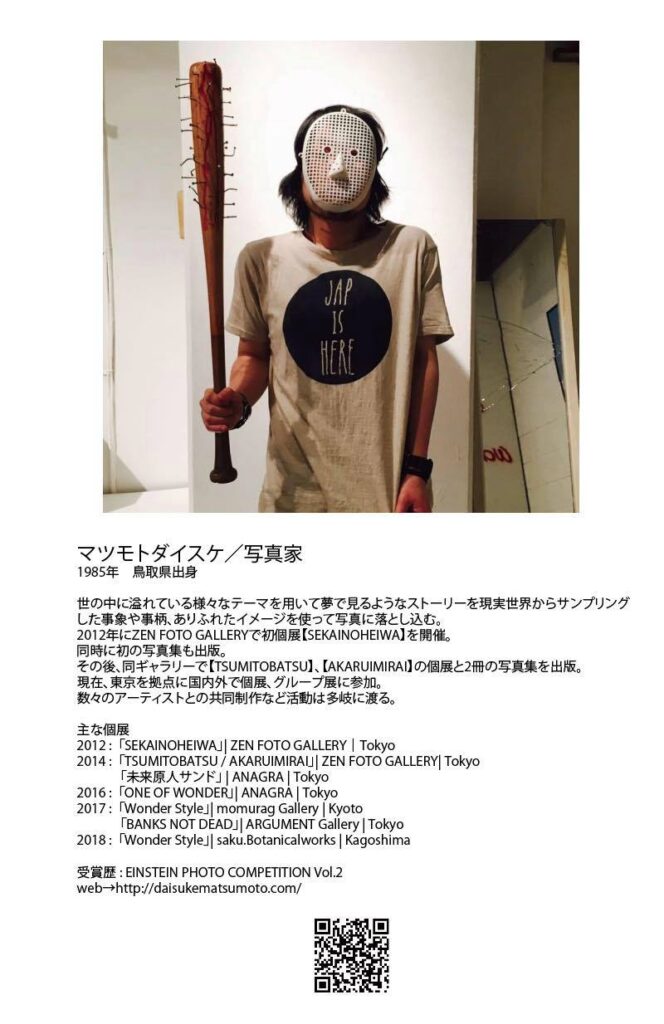
Daisuke Matsumoto / Photographer
Born and raised from Tottori in 1985.
Using a variety of themes that abound in the world, he incorporates dreamlike stories into his photographs using events sampled from the real world and commonplace images.
In 2012, he held his first solo exhibition “SEKAINOHEIWA” at ZEN FOTO GALLERY.
He also published his first photo book.
Since then, he has held solo exhibitions of “TSUMITOBATSU” and “AKARUIMIRAI” at the same gallery, and published two photo books.
Currently based in Tokyo, he has participated in solo and group exhibitions in Japan and abroad.
He has collaborated with many artists in a wide range of activities.
ということでマツモトダイスケさんのインタビューの前編でした。
たまたまかもしれませんが、これまでインタビューした⽅々は「描くことが楽しい!」とい う意⾒が多かったので、新鮮でした。
⽂脈的に作品を形成しながら、また写真というジャンルの中でも型にハマらない世界観を 展開するマツモトダイスケさんはまさに現代写真の極北にあるアートなのだと感じました。
後編では、近々⾏われる展⽰会のエピソードをお届けしますが、次回はそんな世界観をより 深掘りした結果、かなり過激な内容になっております。カメラを通して何を捉えているのか?何を伝えたいのか?そんな話の⼀端に迫ります。
So that was the first part of the interview with Daisuke Matsumoto.
Maybe it’s just a coincidence, but most of the people I’ve interviewed have said that drawing is fun! It was interesting to hear such an interesting perspective.
I felt that Daisuke Matsumoto’s art is the very north of contemporary photography, as he develops an unconventional worldview within the genre of photography while forming his work in a social context.
In the second part of this article, we will report on the episodes of the exhibition that will be held in the near future, but in the next article, we will explore his worldview in more depth, and the contents will be quite extreme. What are you capturing through his camera? What does he want to convey? Let’s take a closer look at one part of the story.
文:THAT IS GOOD編集部:古賀
TEXT : THAT IS GOOD editorial department, Koga